NOKIA TRAINNING
- 格式:ppt
- 大小:1.30 MB
- 文档页数:28
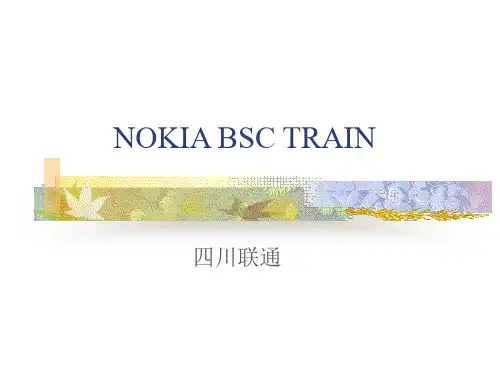
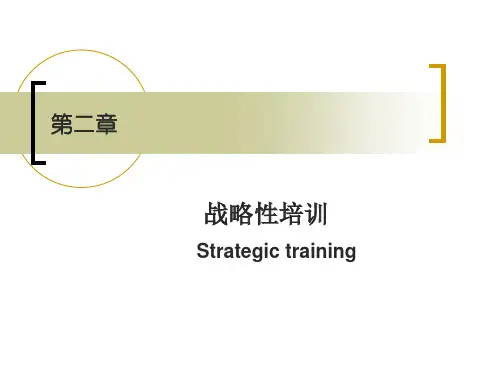
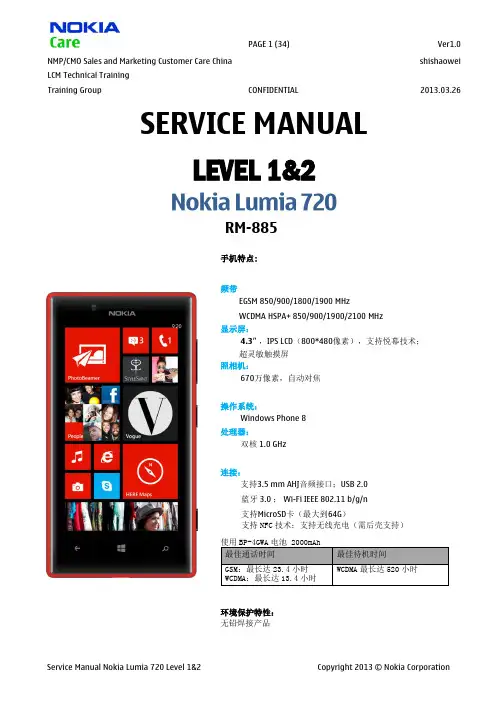



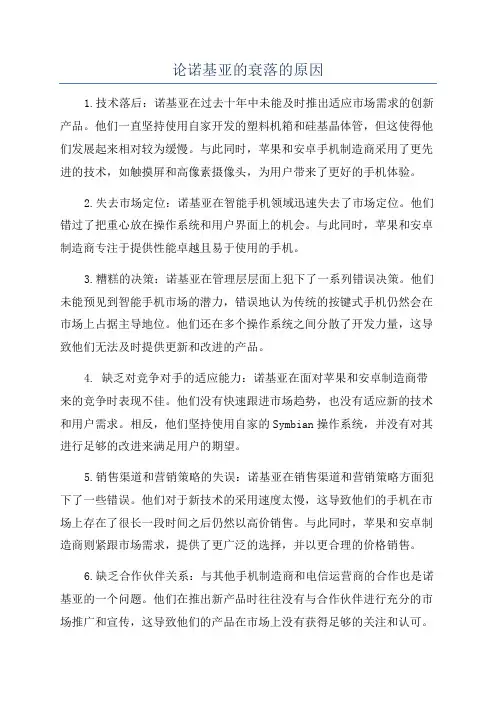
论诺基亚的衰落的原因1.技术落后:诺基亚在过去十年中未能及时推出适应市场需求的创新产品。
他们一直坚持使用自家开发的塑料机箱和硅基晶体管,但这使得他们发展起来相对较为缓慢。
与此同时,苹果和安卓手机制造商采用了更先进的技术,如触摸屏和高像素摄像头,为用户带来了更好的手机体验。
2.失去市场定位:诺基亚在智能手机领域迅速失去了市场定位。
他们错过了把重心放在操作系统和用户界面上的机会。
与此同时,苹果和安卓制造商专注于提供性能卓越且易于使用的手机。
3.糟糕的决策:诺基亚在管理层层面上犯下了一系列错误决策。
他们未能预见到智能手机市场的潜力,错误地认为传统的按键式手机仍然会在市场上占据主导地位。
他们还在多个操作系统之间分散了开发力量,这导致他们无法及时提供更新和改进的产品。
4. 缺乏对竞争对手的适应能力:诺基亚在面对苹果和安卓制造商带来的竞争时表现不佳。
他们没有快速跟进市场趋势,也没有适应新的技术和用户需求。
相反,他们坚持使用自家的Symbian操作系统,并没有对其进行足够的改进来满足用户的期望。
5.销售渠道和营销策略的失误:诺基亚在销售渠道和营销策略方面犯下了一些错误。
他们对于新技术的采用速度太慢,这导致他们的手机在市场上存在了很长一段时间之后仍然以高价销售。
与此同时,苹果和安卓制造商则紧跟市场需求,提供了更广泛的选择,并以更合理的价格销售。
6.缺乏合作伙伴关系:与其他手机制造商和电信运营商的合作也是诺基亚的一个问题。
他们在推出新产品时往往没有与合作伙伴进行充分的市场推广和宣传,这导致他们的产品在市场上没有获得足够的关注和认可。
总体来说,诺基亚在技术创新、市场定位、决策制定、竞争对手适应能力、销售渠道和合作伙伴关系方面都犯下了一些致命的错误,导致他们的衰落。
与此同时,其他手机制造商则在市场上迅速发展并取得成功。
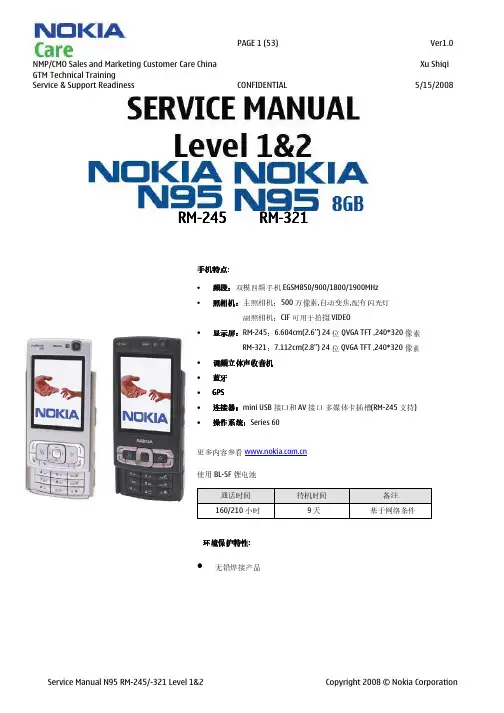
Service & Support ReadinessCONFIDENTIAL5/15/2008RMRM--245245 RM RM RM--323211手机特点:• 频段频段::双模四频手机 EGSM850/900/1800/1900MHz•照相机照相机::主照相机:500万像素,自动变焦,配有闪光灯 副照相机:CIF 可用于拍摄VIDEO• 显示屏显示屏::RM-245:6.604cm(2.6”) 24位QVGA TFT ,240*320像素 RM-321:7.112cm(2.8”) 24位QVGA TFT ,240*320像素 • 调频立体声收音机 • 蓝牙 • GPSGPS • 连接连接器器:mini USB 接口和AV 接口 多媒体卡插槽(RM-245支持) • 操作系统操作系统::Series 60更多内容参看 使用BL-5F 锂电池通话时间 待机时间 备注 160/210小时9天基于网络条件环境保护特性:无铅焊接产品Service & Support ReadinessCONFIDENTIAL5/15/2008维修手册一、二级维修中心专用诺基亚公司版权所有Copyright ©Copyright © Nokia Corporation. Nokia Corporation. 此材料此材料,,包括文件编辑和包括文件编辑和任何相关的电脑程序都受到任何相关的电脑程序都受到诺基亚公司的版权控制保护诺基亚公司的版权控制保护。
诺基亚公司保留所有权利诺基亚公司保留所有权利。
任何或所有关于此材料的复制任何或所有关于此材料的复制,,再造再造,,保存保存,,传播和翻译都需要诺基亚公司的授权认可播和翻译都需要诺基亚公司的授权认可。
此材料所有内容均是保密信息此材料所有内容均是保密信息,,严禁向其它诺基亚未受权认可的公司或个人展示或传播公司或个人展示或传播。
目录页数 1. 指引............................................................................................................................................................................................................................................................................................................................................................................................................................................................................................................................44 2. 一般维一般维修信息修信息.........................................................................................................................................................................................................................................................................................................................................................................................................................................................................55 3. 给维修室工作人员指引的网页. (66)4. N95 RM N95 RM--245手机器件分解图.....................................................................................................................................................................................................................................................................................................................................................................................775. N95 RM N95 RM--245器件外器件外观观............................................................................................................................................................................................................................................................................................................................................................................................................................886. N95_8G RM N95_8G RM--321 手机器件分解图................................................................................................................................................................................................................................................................................................................................................................997. 主板器件位置图......................................................................................................................................................................................................................................................................................................................................................................................................................108. 零配件清单........................................................................................................................................................................................................................................................................................................................................................................................................................................................................119.维修工具 (12)10. 软件升级................................................................................................................................................................................................................................................................................................................................................................................................................................................................................14 11. 上滑部分拆卸步骤介绍............................................................................................................................................................................................................................................................................................................................................................................................15 12. 上滑部分装配步骤介绍............................................................................................................................................................................................................................................................................................................................................................................................18 13. 下滑部分拆卸步骤介绍............................................................................................................................................................................................................................................................................................................................................................................................21 14. 下滑部分拆卸步骤介绍............................................................................................................................................................................................................................................................................................................................................................................................26 15. 简单故障快速排除指引示意图..................................................................................................................................................................................................................................................................................................................................................................32 16. 快速故障排除指引示意图----开机......................................................................................................................................................................................................................................................................................................................33 17. 快速故障排除指引示意图----充电......................................................................................................................................................................................................................................................................................................................34 18. 快速故障排除指引示意图----无网络..............................................................................................................................................................................................................................................................................................................35 19. 快速故障排除指引示意图--------WLAN/WLAN/蓝牙故障............................................................................................................................................................................................................................................................................36 20. 快速故障排除指引示意图--------GPS GPS GPS..........................................................................................................................................................................................................................................................................................................................................................37 21. 快速故障排除指引示意图----听筒. (38)NMP/CMO Sales and Marketing Customer Care China Xu ShiqiGTM Technical Training Service & Support Readiness CONFIDENTIAL 5/15/200822. 快速故障排除指引示意图----免提扬声器 (39)23. 快速故障排除指引示意图----显示屏..............................................................................................................................................................................................................................................................................................................40 24. 快速故障排除指引示意图----麦克风..............................................................................................................................................................................................................................................................................................................41 25. 快速故障排除指引示意图--------ITU ITU 键盘........................................................................................................................................................................................................................................................................................................42 26. 快速故快速故障排除指引示意图障排除指引示意图--------S60S60键盘........................................................................................................................................................................................................................................................................................................43 27. 快速故障排除指引示意图----多媒体键盘............................................................................................................................................................................................................................................................................................44 28. 快速故障排除指引示意图----查看键..............................................................................................................................................................................................................................................................................................................45 29. 快速故障排除指引示意图----音量键..............................................................................................................................................................................................................................................................................................................46 30. 快速故障排除指引示意图----照相键/自动对焦........................................................................................................................................................................................................................................................................47 31. 快速故障排除指引示意图----闪光灯..............................................................................................................................................................................................................................................................................................................48 32. 快速故障排除指引示意图-------- AV AV 接口..........................................................................................................................................................................................................................................................................................................49 33. 快速故障排除指引示意图--------USB USB USB..........................................................................................................................................................................................................................................................................................................................................................50 34. 快速故障排除指引示意图----副照相机....................................................................................................................................................................................................................................................................................................51 35. 快速故障排除指引示意图----主照相机....................................................................................................................................................................................................................................................................................................52 36. 功能测试................................................................................................................................................................................................................................................................................................................................................................................................................................................................................53 37. 网络及通话功能测试 (53)更改记录状态 版本号 日期 备注 draft V1.0 2008-5-14Service & Support ReadinessCONFIDENTIAL5/15/20081. 指引此文档用于指导诺基亚一级与二级维修中心工作间维修技术人员对诺基亚产品进行维修服务。
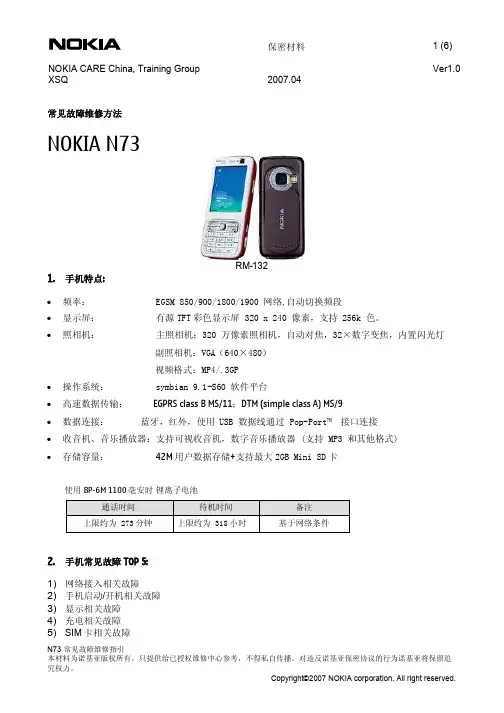
XSQ2007.04常见故障维修方法NOKIA N73RM-1321.手机特点:∙频率:EGSM850/900/1800/1900网络,自动切换频段∙显示屏:有源TFT彩色显示屏320x240像素,支持256k色。
∙照相机:主照相机:320万像素照相机,自动对焦,32×数字变焦,内置闪光灯副照相机:VGA(640×480)视频格式:MP4/.3GP∙操作系统:symbian9.1-S60软件平台∙高速数据传输:EGPRS class B MS/11;DTM(simple class A)MS/9∙数据连接:蓝牙,红外,使用USB数据线通过Pop-Port™接口连接∙收音机、音乐播放器:支持可视收音机,数字音乐播放器(支持MP3和其他格式)∙存储容量:42M用户数据存储+支持最大2GB Mini SD卡使用BP-6M1100毫安时锂离子电池通话时间待机时间备注上限约为273分钟上限约为318小时基于网络条件2.手机常见故障TOP5:1)网络接入相关故障2)手机启动/开机相关故障3)显示相关故障4)充电相关故障5)SIM卡相关故障XSQ2007.043.主板元器件分布图:4.关键元器件:•RAPS :是GSM EDGE 无线应用处理器。
RAPS 运行NOKIA 的操作系统,进行控制与管理所有网络调制解调的工作,也是整个系统得主要核心。
在RAPS 中主要有三部分构成:处理器子系统、MCU 外围设备、DSP 外围设备。
C7538B2200BETTY CMT-COMBO PURX OMAP C7543R1100C2211C2222FEM R7504C7526G1000R7501C7508VCTCXO AVILMA R4420L7520APE-COMBO C4201C2215PIHI L7500N6508L2302C7549V6515C7565N6515J4807C7511L6505RAPS C2213C9079C4404C9079C4403显示屏接口R1101(隐藏)SIM 卡连接器C2012L2000V2000F2000C2317R7692充电触点开关键触片天线触点XSQ2007.04•AVILMA:是主要的能量管理IC,包括下列主要功能模块:1)开机逻辑和复位控制2)充电器的检测3)电池电压监测4)32K时钟和外部振荡器5)实时时钟和外部备用电池6)SIM卡接口7)立体声音频便解码器和功放8)A/D转换器9)调压器10)振动泵接口11)数字接口(CBUS)AVILMA不像UEM一样包括保密部分。
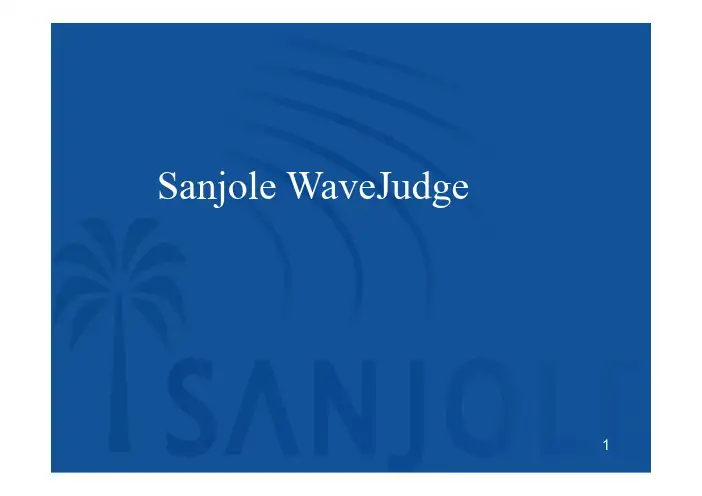
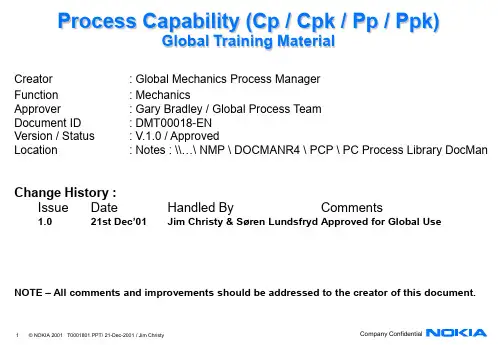
NOKIA手机测试模式参数详解NOKIA手机的测试模式(BTS TEST),通常又称工程模式,有比普通专业测试手机更强的测试功能,它包含了大量的无线参数、GSM系统信息以及数十项手机内部测试功能的显示,比如SIM卡的详细信息、电池的电压、放电电流、温度以及详尽的充电情况。
手机的测试模式对于资金不够充裕的区县移动公司的无线基站维护测试工程师、优化工程师来说,可以在不增加任何投入的情况下,使维护人员能够在任意时刻了解所在基站的情况,对提高维护水平、加强维护力量大有好处。
对手机维修人员和一般的无线电爱好者都有一定的参考价值。
下面将结合GSM网络的基础知识,从实际应用的角度来介绍NOKIA手机测试模式各项显示的专业解释。
开启测试模式的方法很多,一般使用电脑及相关软件、连接线或通过红外线接口激活手机的测试功能。
方法可以参看本人在《电子报》第17期上的介绍,在此不再赘述。
一、进入测试模式方式有三种激活测试模式的方法:1.执行方式,2.数据显示方式,3.帮助显示方式。
使用数据显示方式时,在手机功能表中选择NET MONITOR菜单,进入后输入01,即可看到第1页面无线网络参数,按向下翻页键可看到其他页面的无线网络参数,部分页面被保留,在翻页时会自动被略过,不同手机的相同页面显示可能会有所不同的与手机的硬软件版本有关;长按手机键盘*字键,会出现各项无线参数的简单帮助说明,即是帮助显示方式。
执行方式进入方法同数据显示方式,打开NET MONITOR菜单后直接选择需要执行的页面(这样的页面不多,如页面17、19、60、80、241、242等,如果选择的不是这样的页面,则自动进入数据显示方式);也可以通过菜单快捷方式执行:按功能键->NET MONITOR菜单号码(如12)->执行页面即可。
如果该页面包含一个复位计数器的操作(如80、240页面),一经选择就会立刻执行复位操作。
总之,执行方式是一键进入方式,如要用执行方式进入另一个测试项目,需要重复以上步骤重新进入方可激活。
GTM Technical TrainingTraining Group CONFIDENTIAL 2009.10.27 SERVICE MANUALSERVICE MANUALLEVEL 1&2LEVEL 1&2RMRM--58888手机特点手机特点::频带频带::E GSM:850/900/1800/1900MHz;WCDMAWCDMA : : HSDPA900/2100MHz;显示屏显示屏::LCD: nHD 3.2”, TFT,1600万色(640×360像素),有效显示区域 39.6mm×70.4mm,屏幕纵横比 16:9;照相机照相机::200万像素(1600×1200)CMOS数码相机,3倍数码变焦;操作系统操作系统::Symbian OS 9.4,S60 第五版平台;连接连接::3GPP标准蜂窝式无线电话:GSM+(E)GPRS+WCDMA+HSDPA;无线:蓝牙2.0+DER+A2DP+AVRCP;接口:Micro USB 2.0 接口,3.5毫米AV接口使用BL-5J锂电池通话时间 待机时间 备注 GSM:上限约7小时;WCDMA:上限约4小时18分;GSM:上限约438小时;WCDMA:上限约为458小时;基于网络条件及手机设置环境保护特性环境保护特性::•无铅焊接产品GTM Technical Training Training Group CONFIDENTIAL2009.10.27服务手册服务手册一、二级维修中心专用二级维修中心专用诺基亚公司版权所有Copyright ©Copyright © Nokia Corporation. Nokia Corporation. 此材料此材料,,包括文件编辑和任何相关的电脑程序都受到诺基亚公司的版权控制保护亚公司的版权控制保护。
诺基亚公司保留所有权利诺基亚公司保留所有权利。
Frequently Asked Questions for New York City EducatorsTo help guide your review of Scholastic’s Common Core Code X program, our editors compiled a list of the questions that surfaced at the recent Information Sessions for Instructional Coaches and Principals. Please refer to the questions below to aid you in your review of our program.Table of ContentsProgram Components & Pricing Page 2 Professional Learning Page 3 Instructional Shifts of the Common Core Page 4 Teacher’s Edition Page 6 Support for ALL Learners Page 7 Novel Study Page 9 Writing Page 10 Assessment Page 11Program Components & Pricing1. What components are included with Code X?A: Grade-Specific Student Editions: Include eight Units of Close Reading exemplars, writing tasks, and performance tasks.Grade-Specific Novel Study Trade Books:Grade 6∙Tuck Everlasting, Natalie Babbitt∙Make Lemonade, Virginia Euwer WolffGrade 7∙Inkheart, Cornelia Funke∙I Thought My Soul Would Rise and Fly, Joyce HansenGrade 8∙Monster, Walter Dean Myers∙Endangered, Eliot SchreferGrade-Specific Teacher Editions: Include instruction in Close Readingexemplars, text analysis rubrics, academic vocabulary/word study analysis, and scaffolded writing.Grade-Specific Assessment Guides: Include unit assessments modeled on the PARCC Assessments.2. What components are FREE with the purchase of every class set?A: With the purchase of every class set of 30 Student Editions, Scholastic will provide schools with a FREE set of Novel Study Trade Books (2 books per student per grade), a Teacher’s Edition, and an Assessment Guide.3. What does Code X cost?A: Each class set of 30 Student Editions ($37 each) costs $1,110. With every class set purchased, schools will receive a FREE set of Novel Study Trade Books, a Teacher’s Edition, and an Assessment Guide.4. Is there any technology included with Code X?A: In the near future, a digital edition of both the Student and Teache r’sEdition will be available via desktop computers and tablets.Professional Learning1. What professional learning services does Scholastic provide?A. Scholastic will support New York City Schools with a focused and tailoredprogram of professional learning to support the implementation of Code X.2. What is the cost of the professional learning services?A. The professional learning services outlined above are provided FREE toNYC teachers, coaches, and leaders who purchase Code X.Instructional Shifts of the Common Core State Standards1. How does Code X promote the instructional shifts of the Common Core?A. Balance of Texts: includes a balance of informational and literary text:∙Grade 6 Informational: Memoir, Autobiography, Biography, Essay, Website Excerpt, Magazine Article∙Grade 6 Literary: Short Story, Poetry, Novels, Folk Tale, Drama∙Grade 7 Informational: Memoir, Autobiography, Biography, Essay, Website Excerpt, Magazine Article, News Articles∙Grade 7 Literary: Short Story, Poetry, Novels, Folk Tale, Drama, Graphic Novel∙Grade 8 Informational: Memoir, Autobiography, Biography, Essay, Website Excerpt, Magazine Article∙Grade 8 Literary: Short Story, Poetry, Novels, Folk Tale, Drama, LettersBuilding Disciplinary Knowledge: Texts are selected and sequenced tobuild disciplinary knowledge of topics and subjects covered in the Grades6-8 Science and Social Studies Frameworks. For example, Grade 6, Unit6 explores the following texts that enrich students’ Social Studies focus o nthe Eastern Hemisphere: “New Discoveries in Ancient Egypt” by BryanBrown Scholastic News, Curse of the Pharaohs: My Adventures WithMummies, by Zahi Hawass, and Cities of the Dead by Denise Rinaldo.Staircase of Complexity: To support students in reading increasinglycomplex texts independently, each Unit exposes students to on- andabove-grade level texts. Scaffolded instruction gradually decreases overtime as teachers monitor student learning. Each Unit focuses reading,rereading, and writing on 3-4 short texts that span a variety of literarynonfiction, informational, and fiction text types at an appropriate range oftext complexity. In addition, each Unit includes Literature Circle selectionsthat are below-, on- and above-grade level. Two complete novel studiesare also included within the program.Academic Vocabulary: Code X vocabulary instruction is systematic,efficient, and intensive, centered on both direct instruction and learningfrom context through explicit questioning while reading. Words areselected for intensive teaching as follows:∙Target Words are pretaught before reading and students answer questions about these words in context. Target words are academicvocabulary words that are likely to appear in future texts from anydiscipline. Many of the pretaught and frequently discussed targetwords are also part of a word family or semantic network. Thepreteaching involves defining the words and generating examples,as well as teacher modeling of morphology.∙Words to Know are words students must understand in order to fully comprehend the text. These include concrete words, wordswith single meanings, and words reflecting meaning or shades ofmeaning that are likely to be part of a student’s experience. Theseconcrete words are taught quickly from the context of the textwithout additional activities or exercises.∙Words and Phrases in Context questions, which students encounter during the Close Reading of each text, tackle words thatneed more explanation, taught in context and then reinforced afterthe direct instruction with follow up questioning and illustrative usein Model Writing (because encounters with a word spread out overtime will further increase the likelihood of retention). The wordschosen for Close Reading Words and Phrases in Context questionsinclude abstract words with multiple related meanings or shades ofmeaning that are unusual or unlikely to be part of a student’sexperience.Text-Based Evidence: Questions for each text facilitate rich and rigorous evidence-based discussions in which students:∙Consider the most important learning to be drawn from the text/determine the key ideas of the text. Questions are structuredto bring the reader to a gradual understanding of these.∙Support students in mastering sections of the text that present the greatest difficulty. These could be sections with difficult syntax,particularly dense information, and tricky transitions or placesthat offer a variety of possible inferences.∙Understand and revisit the most powerful academic words in the text and integrate questions and discussions that explore these words.∙Analyze words that have different meanings in different contexts to create awareness of subtle shades of meaning.∙Provide students with an awareness of the strategy and skills they use as they discuss and write about the text. This instructionfocuses student attention on the text through open, meaning-basedquestions about the text.Writing from Sources: Writing is the vehicle through which each writerarticulates understanding of the texts. Daily writing assignments duringClose Reading create opportunities to record and elaborate thinking while reading. The questioning and discussion students engage in during theIdentify Evidence, Key Ideas and Details, and Craft and Structure parts of their text analysis extend the exercise of capturing ideas from textevidence as a foundation for developing, elaborating, and articulatingideas in the final written performance task.Teac her’s Edition1. How is the Teacher’s Edition organized?A. Each grade-level Teacher’s E dition includes a scope and sequence,curriculum map, daily instruction, eight Units of study, ten instructionalroutines, text complexity rubrics, Research Foundations and Resourcesfor Differentiating Instruction.2. What is the suggested pacing for a Code X Unit?A. Each Unit provides approximately one month of instruction. A PlanningGuide that precedes each Unit suggests the number of days to spend on each part of the Unit.∙ 1 Day: Introduce the Unit∙ 1 Day: Teach Academic Vocabulary∙5-7 Days: Close Reading, Daily Writing, and Discussion of Text 1∙ 1 Day: Teach Academic Vocabulary∙5-7 Days: Close Reading, Daily Writing, and Discussion of Text 2∙ 3 Days: Collaborate & Present Assignment∙3-5 Days: Writing Performance Task∙2-3 Days: Extended Readings3. How do I know which Standards are introduced and how theyprogress in each Unit?A. Standards maps in the Teacher’s Editions outline the introduction andprogression of each standard during a year and across one grade to thenext, highlighting:∙Deepening of the cognitive process∙Introduction of new content and skills∙Extension of knowledge and skills to a wider range of content∙Decreasing levels of scaffolding and teacher support4. How do I know what content-area disciplines are taught in each Unit?A. The Unit Overview that precedes each Unit in the Teacher’s Edition listsall the standards and content-area connections/disciplines taught in eachUnit of the knowledge-based curriculum.Support for ALL Learners1. What RTI supports are available in Code X?A. Code X includes daily strategies and teacher modeling to support EnglishLanguage Learners, struggling readers, students with disabilities, andadvanced learners.Vocabulary Instruction: Of the many features of complex text, difficult or uncommon vocabulary presents the greatest challenge for student readers.Direct Instruction of Target Words is delivered through a step-by-stepVocabulary Routine that includes teacher supports on how to adjust forvarious student needs. Students learn new vocabulary through explicitteaching and a consistent instructional sequence.Words and Phrases in Context questions include the following scaffolds: ∙Teacher Modeling of explicit strategies for teaching meaning, such as deepening understanding with conversation (structuring academicdiscussion)∙Additional word family and shades of meaning work to challenge and stretch∙Target Word image library on the Interactive Teaching System (available Fall)∙Spanish Cognate supportDaily Instructional Routines: There are ten routines teachers use throughout the course of a Unit. They focus on the instructional shifts, supporting teachers to internalize the shifts in their practice as they: ∙Provide students with processes for expressing ideas in order to study, review, and learn content material, rethink content, and process ideas ∙Place students in an active reading and learning role∙Serve as tools to assess students’ understanding of key ideas in text ∙Equip students with highly portable literacy and communication skillsThe ten routines, which all include specific strategies for differentiating for English Language Learners, struggling readers, students with disabilities, and advanced students, include the following:∙Reading Routines provide opportunities to build fluency through modeled reading. Partner reading gives students a way to build orallanguage with partner talk as well as additional fluency practice. During independent reading, students build stamina and articulateunderstanding.∙The Summarize routine gives teachers a consistent process to teach summarizing and provides students with clear expectations for how towrite a summary and what it should include.∙The Socratic Seminar routine supports students to ask compelling questions and listen to multiple points of view. Students must study the text prior to the seminar and listen actively. Students can takeownership of their learning.Support for Structured Academic Interaction promotes confident and competent participation by all students. Code X teachers follow explicit and systematic instruction of academic language to give students the tools they need to comprehend text and participate in formal speaking and writing tasks.∙Structured engagement routines such as Think (Write)-Pair-Share and the Socratic Seminar encourage social interaction and increase thequality of student responses.∙Teacher instruction allows time for students to digest questions and tasks before preparing responses.∙All students are held accountable for responding to questions and tasks and are provided supports, such as sentence starters andsentence frames, in order to convey perspectives and communicatefeedback.Structured Approaches to Teaching Writing provide meaningful support to ensure writing success for all students. These supports include:∙Clear learning objectives∙Explicit modeling of lexical and grammatical expectations with written texts∙Guidance, including structured discussion and conceptual organizers, for developing topics∙Clear definitions, concrete examples, and multiple opportunities for practice∙Specific feedback based on learning objectives that focuses on strengths, emphasizes one or two high-priority corrections toemphasize, focuses on grammar skills and provides further instructionand practice in identified areas of need∙Specific evaluation criteria established and taught with rubricsNovel Study1. How do full-length novels fit into the curriculum?A. In addition to each of the eight Units, Code X Literature Study providesapproximately 25 days of Instruction to guide teachers and studentsthrough reading two full-length novels per grade. Instruction accompanies sections of the text as follows:∙Teacher-Lead Modeling and Guided Work: Teachers lead textual analysis of the key ideas/details and craft/structure of the earliest andmost challenging chapters.∙Independent Study: Students read sections of the novel independently, analyzing Key Ideas and Details and Craft and Structure.∙Independent Writing: Students produce 4-5 single and multi-paragraph writing assignments leading to a culminating performance task for thenovel study that integrates knowledge and ideas.2. Which novels will Scholastic provide FREE per grade?A. Grade 6∙Tuck Everlasting, Natalie Babbitt∙Make Lemonade, Virginia Euwer WolffGrade 7∙Inkheart, Cornelia Funke∙I Thought My Soul Would Rise and Fly, Joyce HansenGrade 8∙Monster, Walter Dean Myers∙Endangered, Eliot Schrefer3. How do readers access full-length works that are below-, on-, andabove-grade level?A. In addition to the full-length novels included with Code X, three LiteratureCircle options enable teachers to incorporate even more literature intoeach Unit. Literature Circle Guides provide discussion questions andinstruction for quality novels found in many middle and high schoolclassroom libraries. Selected for their ability to provoke critical thinkingand discussion, each Literature Circle novel helps students develop thecomprehension and literary analysis skills they'll need to be lifelongreaders.Writing1. How are the “green pages” designed to guide students through theCode X Writing Process?A. The Code X Writing Process is a series of steps that writers use toarticulate their ideas in a piece of writing. The Code X supports students in writing argument, informative, and narrative texts using the WritingProcess so that students internalize key text structures as well as thesteps that effective writers follow. Before beginning the process, studentsanalyze a model and determine key features of the structure. Dependingon student needs and pace, the Writing Process may take three of moredays of instruction.As students develop their topics, they pull from the many days of on-demand daily writing they have done throughout their text analysis.Writer’s Craft questions give students brief and frequent practice withacademic writing. The answers that students craft during text analysis help them develop their topics during the Code X Writing Process whichincludes the following steps:∙Read the Model∙Analyze the Model∙Plan∙Develop the Topic∙Writer’s Craft∙Focus on Writer’s Craft∙Draft∙Skill Builder∙ReviseAssessment1. How does Code X prepare students for success on the NextGeneration Assessments?A. Throughout Code X, students are assessed in the following ways:∙Informal Assessments: Daily on-demand writing and assignments focus on Key Ideas and Details and Craft and Structure throughout the Unit.∙Collaborate and Presentation Assignments: Students draw on their analysis of Unit texts to create websites, debate, dramatize scenes,analyze film versions of texts, collaborate on research questions, etc.They assess their collaborations with a student-facing rubric.∙Performance Tasks: Each Unit Performance Task focuses on reading, writing, speaking and listening, and research claims. These tasks measure capacities such as depth of understanding, interpretive and analyticalability, synthesis, and research. They take place over the course of theone-month Unit.∙Three Assessment Guides—one each for Grades 6-8 — provide evidence-based selected response and constructed-response Items in order to: - A ssess students’ understanding of the Unit Texts- Give teachers multiple data points for determining grades- P rovide practice with the each of the “new” assessment items2. How do students and teachers use rubrics to assess and evaluatestudent work?A. Students and teachers use three student-friendly, standard-based, task-specific rubrics to assess the written Performance Task and theCollaborate & Present assignment.。